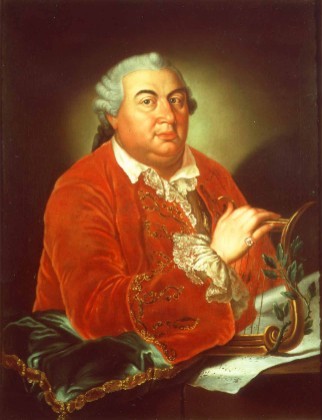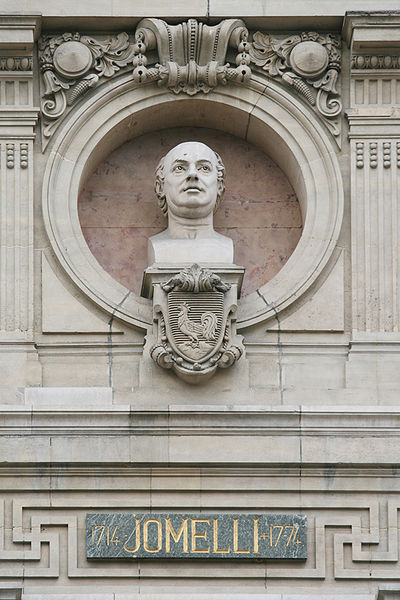<Back to Index>
- Physicist Arthur Holly Compton, 1892
- Composer Niccolò Jommelli, 1714
- Governor of Buenos Aires Hernando Arias de Saavedra, 1561
PAGE SPONSOR


Niccolò Jommelli (10 September 1714 – 25 August 1774) was an Italian composer. He was born in Aversa and died in Naples. Along with other composers mainly in the Holy Roman Empire and France, he made important changes to opera and reduced the importance of star singers.
Jommelli was born to Francesco Antonio Jommelli and Margarita Cristiano in Aversa, a town some 20 kilometres north of Naples. He had one brother Ignazio, who became a Dominican monk and helped the composer in his old age, and three sisters. His father was a prosperous linen merchant, who entrusted Jommelli to the choir director of the cathedral, Canon Muzzillo.
As he had shown talent for music Jommelli was enrolled in 1725 at the Conservatorio di Santo Onofrio a Capuana in Naples, where he studied under Ignazio Prota and Francesco Feo. Three years later he was transferred to the Conservatorio di Santa Maria della Pietà dei Turchini, where he was trained under Niccolò Fago, having Don Giacomo Sarcuni and Andrea Basso, as second maestri, that is, singing teachers (maestri di canto).
Jommelli studied music under Canon Muzzillo, the director of the Aversa cathedral choir. In 1725 he was sent to the Conservatorio Sant' Onofrio at Naples, and studied alongside Francesco Feo and Tommaso Prota. In 1728 he moved to the Conservatorio dei Turchini, and was taught by Nicola Fago (among others). He was greatly influenced by Johann Adolph Hasse, who was in Naples during this period. After completing his studies he began work, and wrote two opere buffe, L’errore amorosa in early 1737 and Odoardo in late 1738. His first opera seria, Ricimero re di Goti, was such a success in Rome in 1740 that work was immediately commissioned from him by Henry Benedict Stuart, the Cardinal - Duke of York.
When still studying at the conservatory, Jommelli was impressed with Hasse’s use of obbligato recitative to increase the tension at certain dramatic moments in his operas. Speaking of obbligato recitative for Ricimero, Charles de Brosses says that Jommelli’s use of obbligato recitative was better than anything he had heard in France.
His first opera, the comedy L’errore amoroso,
was presented, with great success, under the protection of the Marquis
del Vasto, Giovanni Battista d’Avalos, the winter of 1737 in the Teatro
Nuovo of Naples. It was followed in the next year by a second comic
opera, Odoardo, in the Teatro dei Fiorentini. His first serious opera Ricimero rè de’ Goti,
presented in the Roman Teatro Argentina in January 1740, brought him to
the attention and then the protection of the Duke of York, Henry
Benedict. The duke would later be raised to the rank of cardinal and
procure Jommelli an appointment at the Vatican. During the 1740s
Jommelli wrote operas for many Italian cities: Bologna, Venice, Turin, Padua, Ferrara, Lucca, Parma, along with Naples and Rome. When in Bologna in 1741, for the production of his "Ezio", Jommelli (in a situation blurred with anecdotes) met Padre Martini. Saverio Mattei said
that Jommelli studied with Martini, and acknowledged to have learned
with him ‘the art of escaping any anguish or aridity’. Nevertheless,
Jommelli’s constant travelling in order to produce his many operas
seems to have prevented him from ever having any lessons on a regular
basis. Moreover, Jommelli’s relationship with Martini was not without
mutual criticism. The main result of his stay in Bologna and his
acquaintance with Martini was to present to the Accademia Filarmonica of
that city for the procedures of admission, his first known church
music, a five - voice fugue a cappella, on the final words of the small
doxology, the ‘Sicut Erat’. The musicologist Gustav Fellerer,
who examined several such works testifies that Jommelli’s piece, though
being just ‘a rigid school work’, could well rank among the best
admission pieces now stored in the Bolognese Accademia Filarmonica.
During the early 1740s Jommelli wrote an increasing amount of religious
music, mainly oratorios, and his first liturgical piece still extant, a
very simple "Lætatus sum" in F major dated 1743, is held in the
Santini collection in Münster. In 1741 Jommelli went to Bologna to compose the music for Metastasio's Ezio, studying for a time under the famous Franciscan Friar and musician, Father Giovanni Battista Martini and becoming a lifelong friend of his. He was admitted to the Accademia Filarmonica. Shortly afterwards he moved to Venice, and composed his opera Merope, which
was the forerunner for the French style of opera later in the century.
In the years immediately after this, he wrote operas for Venice, Turin,
Bologna, Ferrara, and Padua, and two popular oratorios, Isacco figura del Redentore and Betulia liberata. Some
time around 1745, Hasse recommended Jommelli for a position as the
Director of Music at the Ospedale degli Incurabili in Venice, one of
that city's colleges for female musicians. This full-time employment
required him to compose sacred music (mostly settings of the Mass and the Divine Office), but the financial security it gave him also allowed him to compose several other dramatic works. The appointment of Jommelli, recommended by Hasse, as maestro di cappella to the Ospedale degl’ Incurabili in
Venice is not definitively documented. However, in 1745 he did start
writing religious works for women’s choir to be performed in the church
of the Incurabili, San Salvatore, a duty that was — together with the
tuition of the more advanced students of the institution — part of the
chapel master’s obligations. There are no autographs of Jommelli’s
music composed for the Incurabili, but there are many copies of
different versions of several of his works that may, with some
certainty, be attributed to his period as maestro there. Among the music Helmut Hochstein lists
as being composed for Venice, are to be found four oratorios: "Isacco
figura del Redentore", "La Betulia liberata", "Joas", "Juda proditor";
some numbers in a collection of solo motets called Modulamina Sacra;
one Missa breve in F major with its Credo in D major, probably a second
mass in G major, 47 one Te Deum, and five psalms.
Though
some his earliest biographers, Mattei and Villarosa, give 1748 as the
year when Jommelli gave up his employment in Venice, his last
compositions for the Incurabili are from 1746. He must have left Venice
at the very end of 1746 or at the beginning of the following year,
because on 28 January 1747 Jommelli was staging at the Argentina
theatre in Rome his first version of the "Didone abbandonata", and in
May at San Carlo theatre in Naples a second version of "Eumene".
It
was the need of an active chapel master for the basilica of Saint
Peter’s in reaching for the Jubilee festival year that brought both
Jommelli and Davide Perez to
Rome in 1749. The Jubilee is a year long commemoration which the Roman
Catholic Church holds every fifty years. Therefore this was an
important occasion for Roman aristocratic society to show off. Jommelli
was summoned by the Cardinal Duke of York, Henry Benedict, for whom he
wrote a setting of Metastasio's oratorio La passione di Gesù Cristo that continued to be played yearly in Rome, and who presented him to Cardinal Alessandro Albani, an intimate of Pope Benedict XIV.
He subsequently visited Vienna before taking a post as Kapellmeister to Duke Karl Eugen of Württemberg in Stuttgart in
1753. This period saw some of his greatest successes and the
composition of what are regarded as some of his best works. Many were
staged at the Duke's private theatres in the Palace of Ludwigsburg, outside Stuttgart. Mozart and his father passed through Ludwigsburg in 1763 on their "grand tour" and met the composer. Jommelli returned to Naples in 1768, by which time opera buffa was more popular than Jommelli's opera seria, and his last works were not so well received. He suffered a stroke in 1771 which partially paralysed him, but continued to work until his death three years later. He died in Naples.
Jommelli wrote cantatas, oratorios and other sacred works, but by far the most important part of his output were his operas, particularly his opere serie of which he composed around sixty examples, several with libretti by
Metastasio. In his work, he tended to concentrate more on the story and
drama of the opera than on flashy technical displays by the singers, as
was the norm in Italian opera at that time. He wrote more ensemble
numbers and choruses, and, influenced by French opera composers such as Jean - Philippe Rameau, he introduced ballets into his work. He used the orchestra (particularly the wind instruments)
in a much more prominent way to illustrate the goings-on of the story,
and wrote passages for the orchestra alone rather than having it purely
as support for the singers. From Johann Adolph Hasse, he learnt to write recitatives accompanied by the orchestra, rather than just by a harpsichord. His reforms are sometimes regarded as equal in importance to Christoph Willibald Gluck's.